FRONTIERLAND
When Disneyland opened in 1955, Frontierland was a coup. Americans were downright in love with stories of the American frontier, the romances of the Old West, Davy Crockett, The Lone Ranger, and stories of cowboys and Indians. Just as the exotic jungle rivers of the world would always be an exciting place in the minds of Americans, it seemed that the stories of the Old West would be forever adored and celebrated.
Problem is, it didn’t quite work out that way. In the years following the parks opening, the concept of the Old West simply faded from pop culture and arguably hasn’t returned since. By the 1970s, Disney was aware that Frontierland was a little too slow for modern audiences. In 1976, Disney announced an aggressive expansion plan that would rename the land Westernland and equip it with what it needed to capture the hearts of modern audiences.
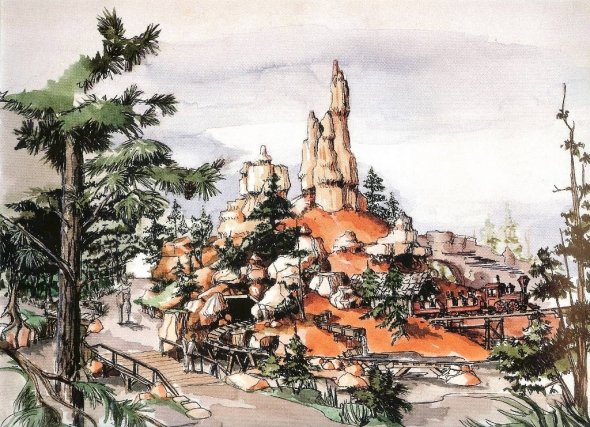
One piece of that growth – Big Thunder Mountain – came online in 1979. The runaway mine train roller coaster through red rock bluffs gave new energy and excitement to the sleepy 1860s setting. But in Possibilityland, the rest of the story becomes clear.
Discovery Bay
Opened: 1979
Status: A full land, continuing the Frontierland story and bridging the gap to Fantasyland
As you walk pass Big Thunder Mountain with the Rivers of America to your left, you might imagine that the story of Frontierland represents a piece of America’s story; the “Westward Ho!” movement when Americans were promised that it was their right – nay, their destiny! – to expand westward to the sea. En route, the Gold Rush attracted settlers to mining towns like Frontierland where the promise of limitless riches hiding in mystical mountains seemed to capture their enthusiasm.
In that way, Big Thunder Mountain filled an important role that had been missing from Frontierland. It answered the question, “What did those settlers find when they eventually made it to the sweeping vistas of the old west?” They found an active gold mine, a runaway mine train, exotic desert wildlife, and the promise of fortune and glory, right? But that was only part of the story.
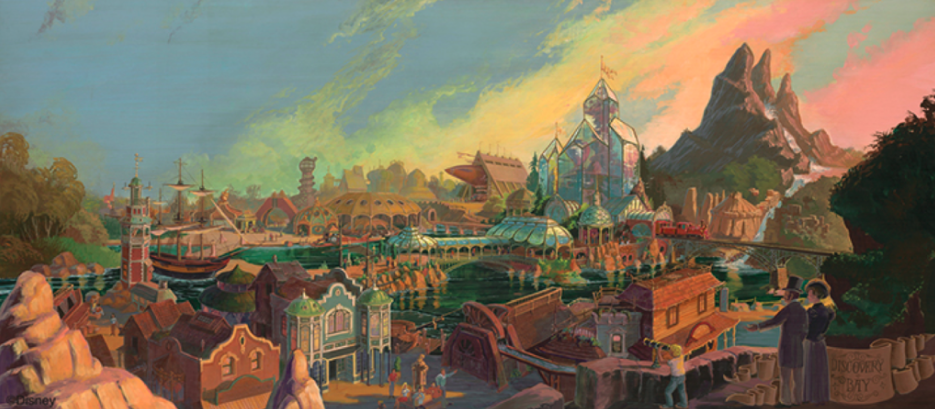
As you continue to walk along the banks of the Rivers of America, you might wonder to yourself: “Once those settlers found the gold buried deep inside of Big Thunder Mountain… what would they do with it?” Would they settle down in the sleepy mining town of Rainbow Ridge? Of course not. Those miners-turned-millionaires would continue west! They would travel until they reached the ocean, where they would build San Francisco. But in this alternate timeline, the port city they built was a little different from the San Francisco we know today.
Coming into view along the northern edge of Tom Sawyer Island is something unbelievable: a towering lighthouse built into a rocky outcropping. This visual icon serves to draw guests from both Frontierland and Fantasyland to the new Discovery Bay land, which – fittingly – unites them both. Big Thunder Mountain is an intersection between the three lands, operating brilliantly in each. But as you draw closer and closer to the lighthouse out in the Rivers of America, the sights of Discovery Bay come into view.
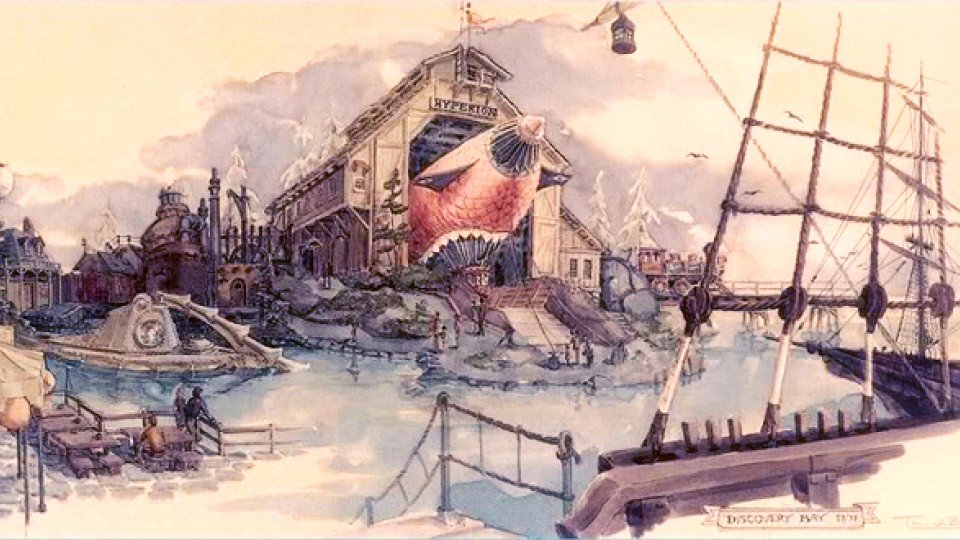
First, you’ll notice that Discovery Bay is not quite like the San Francisco we know. Instead, it’s set in the 1880s as a fantasy fiction harbor where the works of Jules Verne might feel right at home – Victorian buildings, crystal towers, time machines, submarines, and dormant volcanoes cascading with water. Discovery Bay’s placement along the Rivers of America (with Critter Country, New Orleans Square, and Frontierland) signals that it’s an important piece of the American story, even if this one isn’t rooted in fact.
Made of a Waterfront, City Streets, and a remote Carnival outside of town, Discovery Bay would include incredible, fantastic, fantasy rides borrowing from the feel of Jules Verne’s adventure novels. Voyage to the Top of the World would be a dark ride to a mystical Viking island; Captain Nemo’s Adventure underwater simulator; the Lost River boat ride through ancient jungles of animatronic dinosaurs; and the spectacular Professor Marvel’s Gallery of Wonders.
In fact, if you want the full story of and tour through the never-built land of immigrants, inventors, artists, and adventurers, make the jump to our standalone Possibilityland: Discovery Bay feature for the entire history.
Geyser Mountain
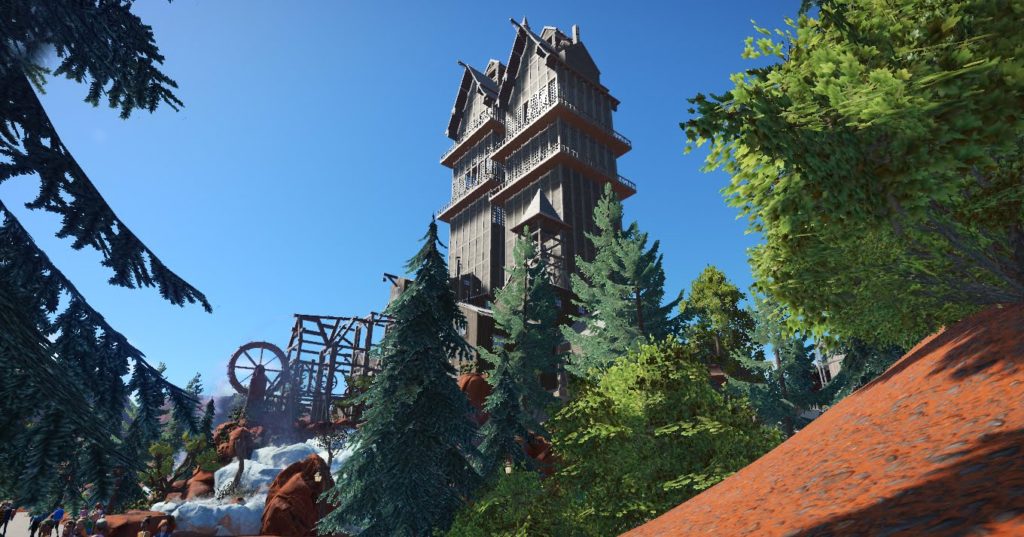
Opening Date: 2003
Status: A ride within Frontierland
If you step out of Discovery Bay and back toward Big Thunder Mountain, you’ll find the quaint, quiet Big Thunder Trail, a peaceful and calm path connecting Frontierland, Fantasyland, and Discovery Bay. This quiet corner of Possibilityland is also home to one of the more unique attractions the park has to offer. Along Big Thunder Trail directly north of Big Thunder Mountain, a path breaks off to the north as it twists through thick forests, towering pines, carved red rock arches, and fanciful “hoodoo” eroded rock formations typical of Bryce Canyon in Utah. As you progress further and further down this winding path, bubbling hot springs and mud pots appear in the forest, eventually giving way to steaming, small geysers that burst from rocky steppes.
The increasing geothermal activity seems to be centered on a craggily, rumbling mountain peak directly ahead. Geyser Mountain appears as an imposing stone peak with cascading water falls tumbling from holes that appear to have been drilled into the mountainside. Entering into the frontier-style barn nestled at the mountain’s peak, you pass through a detailed queue documenting that the fella responsible for boring those holes is a wild and kindly inventor who was mapping out the mountain’s interior for finding a geothermal power source. His detailed maps point out one particularly powerful geyser at the mountain’s core (totally unpredictable, of course) that may be worth exploring, if only he could nail down its schedule of eruption.
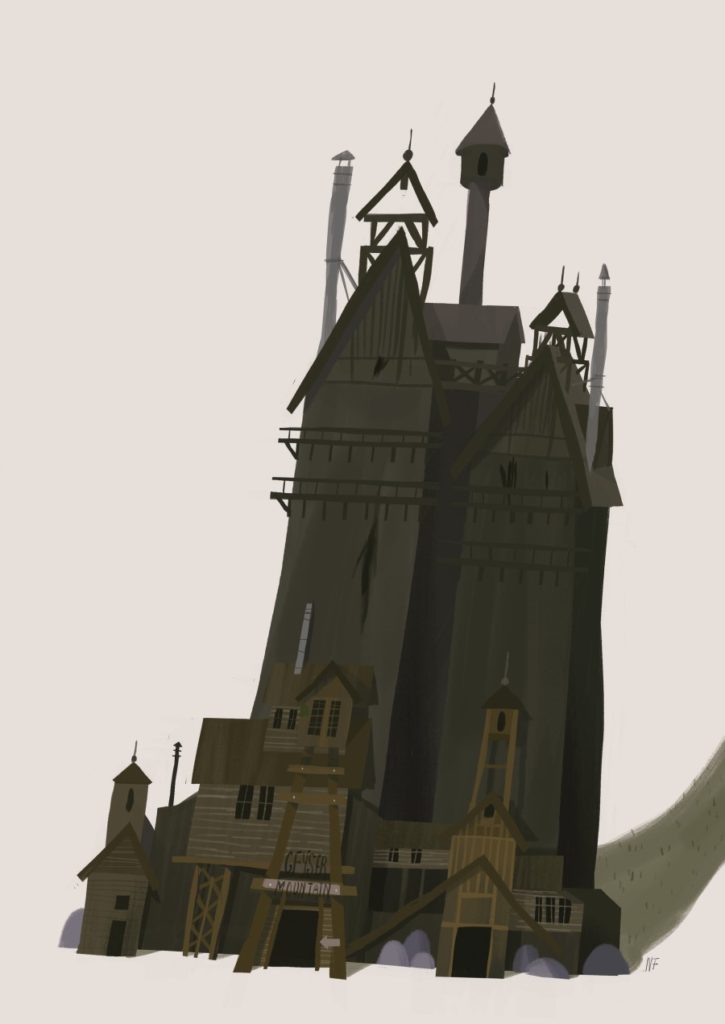
Geyser Mountain is a clever evolution of the technology behind The Twilight Zone Tower of Terror at Disney’s Hollywood Studios in Florida. Here, the old mining elevator that the inventor has rigged up deep inside of the peak can allow us to see the wonders of Geyser Mountain up close – a stop at glittering, seemingly endless crystals; a view of dripping stalactites and roaring underground waterfalls… Of course, in one final breathtaking show scene, a rumbling deep in the mountain’s core signals the awakening of the peak’s most powerful geyser, which catches the elevator and blasts it sky high. The rest of the ride is spent bouncing atop the geyser before being safely returned to the inventor’s cabin.
Not only did Geyser Mountain bring the Tower of Terror technology to the West Coast, but it flipped it around. Instead of focusing on a faster-than-gravity freefall from a broken elevator, it’s the sky-high launch of Geyser Mountain that elicits shrieks from guests. And most importantly, Geyser Mountain’s 2003 opening was a purposeful ploy to draw guests away from the brand new Disney’s California Adventure. Executives imagined that the new park would be so crowded – even two years after its 2001 opening – that Disneyland would need a new E-ticket to bring guests back to the original park.
As you exit back onto the calm Big Thunder Trail, you’re likely to notice the hot air balloons floating silently and gracefully overhead. Those balloons are from The Western Balloon Ascent, a Skyway-style attraction departing from a grassy hillside in Discovery Bay. Those drifting balloons are heading to our next destination and another land you’ll only find in Possibilityland…



